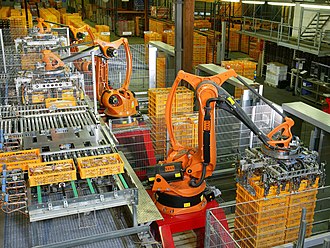Industrial revolution
Overview
| Handcraft | Industry 1.0 | Industry 2.0 | Industry 3.0 | Industry 4.0 | |
|---|---|---|---|---|---|
| Revolutionary innovations | Simple mechanization | New industries, mass production | Computer & automation | Networking, data market | |
| Key enablers | Fire, tools | Steam engine, Renewable energies | Chemical and physical findings, production line | Digital technology, robots, drones, simulation | Digitization, networks, interfaces, digital communication, artificial intelligence, machine learning, 5G, quantum technologies |
| Technological basis | Muscle power | Coal, iron | Electricity | Microelectronics | Software, computer science |
| Missing |
Industry 1.0
The industrial revolution began in England in the second half of the 18th century and brought a change from handcrafted forms of production to the mechanization of production with steam engines or regenerative energy sources such as water.
Industry 2.0
The second industrial revolution was marked by the economic use of new chemical and physical knowledge and the beginning of new industries such as the chemical and pharmaceutical industries, electrical engineering and mechanical engineering. It began at the end of the 19th century in Germany and led to the introduction of the assembly line (1913 at Ford) and to new forms of industrial organization.
Industry 3.0
At the end of the 20th century, the development of microelectronics, digital technology and computers ushered in the third industrial revolution, which allowed automated control of industrial production and revolutionized data processing in offices (computers, laptops) as well as in private environments (computers, mobile phones, game consoles).
Industry 4.0
The fourth industrial revolution uses the technical principles of the third revolution but leads to a completely new transparency of information through the networking of all machines, equipment, sensors and people in production and operation. Industry 4.0 enables feedback and feedforward loops to be established in production, trends to be determined through data analysis and a better overview to be gained through visualization. This development is driven by:
- new communication channels, such as 5G
- new computer technologies for evaluation, like GPGPUs (General Purpose Computation on Graphics Processing Unit), special hardware for AI (Artificial Intelligence) calculations and quantum computers
- and new ways to protect data from manipulation, such as quantum cryptography and blockchains.
In addition, it will be possible for cyberphysical systems to make decisions independently.
The term Industry 4.0 originates from the year 2011. Within a very short time, especially in Germany, many projects and groups were created with the aim of standardizing the development, like the Platform Industry 4.0 and the International Data Spaces Association (IDSA). Without them, the fourth revolution cannot function. Similarly, the Industrial Internet Consortium (IIC) was established in the USA in 2014 working on the IIoT standards. In the offices, in the private environment as well as in society, the ever-increasing networking, e.g. through social networks, is leading to further revolutionary changes.
As already indicated, the first three industrial revolutions were declared by historians. The fourth, on the other hand, uses the term “4.0” to introduce it. For the reasons given above, however, it might be appropriate to speak already of a fourth revolution. However, only history will show whether it is worthy of the name.



